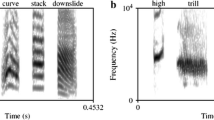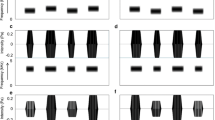Abstract
A hallmark of the human language faculty is the use of syntactic rules. The natural vocalizations of animals are syntactically simple, but several studies indicate that animals can detect and discriminate more complex structures in acoustic stimuli. However, how they discriminate such structures is often not clear. Using an artificial grammar learning paradigm, zebra finches were tested in a Go/No-go experiment for their ability to distinguish structurally different three-element sound sequences. In Experiment 1, zebra finches learned to discriminate ABA and BAB from ABB, AAB, BBA, and ABB sequences. Tests with probe sounds consisting of four elements suggested that the discrimination was based on attending to the presence or absence of repeated A- and B-elements. One bird generalized the discrimination to a new element type. In Experiment 2, we continued the training by adding four-element songs following a ‘first and last identical versus different’ rule that could not be solved by attending to repetitions. Only two out of five birds learned the overall discrimination. Testing with novel probes demonstrated that discrimination was not based on using the ‘first and last identical’ rule, but on attending to the presence or absence of the individual training stimuli. The two birds differed in the strategies used. Our results thus demonstrate only a limited degree of abstract rule learning but highlight the need for extensive and critical probe testing to examine the rules that animals (and humans) use to solve artificial grammar learning tasks. They also underline that rule learning strategies may differ between individuals.
Access this article
We’re sorry, something doesn't seem to be working properly.
Please try refreshing the page. If that doesn't work, please contact support so we can address the problem.



Similar content being viewed by others
References
Abe K, Watanabe D (2011) Songbirds possess the spontaneous ability to discriminate syntactic rules. Nat Neurosci 14:1067–1173
Beckers GJL, Bolhuis JJ, Okanoya K, Berwick RC (2012) Birdsong neurolinguistics: songbird context free grammar is premature. NeuroReport 23:139–145
Berwick RC, Okanoya K, Beckers GJL, Bolhuis JJ (2011) Songs to syntax: the linguistics of birdsong. Trends Cogn Sci 15:113–121
Bolhuis JJ, Okanoya K, Scharff C (2010) Twitter evolution: converging mechanisms in birdsong and human speech. Nat Rev Neurosci 11:747–759
Corballis MC (2007) Recursion, language and starlings. Cogn Sci 31:697–704
Corballis MC (2009) Do rats learn rules? Anim Behav 78:E1–E2
Creel SC, Newport EL, Aslin RN (2004) Distant melodies: statistical learning of nonadjacent dependencies in tone sequences. J Exp Psychol Learn 30:1119–1130
Doupe AJ, Kuhl PK (1999) Birdsong and human speech: common themes and mechanisms. Annu Rev Neurosci 22:567–631
Endress AD (2010) Learning melodies from non-adjacent tones. Acta Psychol 135:182–190
Endress AD, Scholl BJ, Mehler J (2005) The role of salience in the extraction of algebraic rules. J Exp Psychol Gen 134:406–419
Endress AD, Dehaene-Lambertz G, Mehler J (2007) Perceptual constraints and the learnability of simple grammars. Cognition 105:577–614
Endress AD, Cahill D, Block S, Watumull J, Hauser MD (2009a) Evidence of an evolutionary precursor to human language affixation in a non-human primate. Biol Lett 5:749–751
Endress AD, Nespor M, Mehler J (2009b) Perceptual and memory constraints on language acquisition. Trends Cogn Sci 13:348–353
Endress AD, Carden S, Versace E, Hauser MD (2010) The apes’ edge: positional learning in chimpanzees and humans. Anim Cogn 13:483–495
Folia V, Uddén J, de Vries M, Forkstam C, Petersson KM (2010) Artificial language learning in children and adults. Lang learn 60(suppl 2):188–220
Fountain SB, Rowan JD (1995) Sensitivity to violations of “run” and “trill” structures in rat serial-pattern learning. J Exp Psychol Anim Behav Process 21:78–81
Frank MC, Slemmer JA, Marcus GF, Johnson SP (2009) Information from multiple modalities helps 5-month-olds learn abstract rules. Dev Science 12:504–509
Gebhart AL, Newport EL, Aslin RN (2009) Statistical learning of adjacent and nonadjacent dependencies among nonlinguistic sounds. Psychon Bull Rev 16:486–490
Gentner TQ, Fenn KM, Margoliash D, Nusbaum HC (2006) Recursive syntactic pattern learning by songbirds. Nature 440:1204–1207
Gerken L (2006) Decisions, decisions: infant language learning when multiple generalizations are possible. Cognition 98:B67–B74
Gomez RL, Gerken L (2000) Infant artificial language learning and language acquisition. Trends Cogn Sci 4:178–186
Hauser MD, Glynn D (2009) Can free-ranging rhesus monkeys (Macaca mulatta) extract artificially created rules comprised of natural vocalizations? J Comp Psychol 123:161–167
Hauser MD, Newport AL, Aslin RN (2001) Segmentation of the speech stream in a non-human primate: statistical learning in cotton-top tamarins. Cognition 78:B53–B64
Hauser MD, Chomsky N, Fitch WT (2002a) The faculty of language: what is it, who has it and how did it evolve? Science 298:1569–1579
Hauser MD, Weiss D, Marcus GF (2002b) Rule learning by cotton-top tamarins. Cognition 86(1):B15–B22
Hauser MD, Weiss D, Marcus GF (2010) Rule learning by cotton-top tamarins Retraction of vol 86 pg B15, 2002. Cognition 117:106
Herbranson WT, Shimp CP (2008) Artificial grammar learning in pigeons. Learn Behav 36:116–137
Holveck MJ, Viera de Castro AC, Lachlan RF, ten Cate C, Riebel K (2008) Accuracy of song syntax learning and singing consistency signal early condition in zebra finches. Behav Ecol 19:1267–1281
Marcus GF (2006) Language- startling starlings. Nature 440:1117–1118
Marcus GF, Vijayan S, Rao SB, Vishton PM (1999) Rule learning by seven-month-old infants. Science 283:77–80
Murphy RA, Mondragon E, Murphy VA (2008) Rule learning by rats. Science 319:1849–1851
Newport EL, Aslin RN (2004) Learning at a distance I: statistical learning of non-adjacent dependencies. Cogn Psychol 48:127–162
Newport EL, Hauser MD, Spaepen G, Aslin RN (2004) Learning at a distance II. Statistical learning of non-adjacent dependencies in a non-human primate. Cogn Psychol 49:85–117
Saffran JR, Aslin RN, Newport EL (1996) Statistical learning by 8-month-old infants. Science 274:1926–1928
Saffran JR, Johnson EK, Aslin RN, Newport EL (1999) Statistical learning of tone sequences by human infants and adults. Cognition 70:27–52
Saffran JR, Pollak SD, Seibel RL, Shkolnik A (2007) Dog is a dog is a dog: infant rule learning is not specific to language. Cognition 105:669–680
Saffran JR, Hauser MD, Seibel R, Kapfhamer J, Tsao F, Cushman F (2008) Grammatical pattern learning by human infants and cotton-top tamarin monkeys. Cognition 107:479–500
Sokal RR, Rohlf FJ (1995) Biometry: the principles and practice of statistics in biological research. Freeman and Co, New York
ten Cate C, Okanoya K (2012) Revisiting the syntactic abilities of non-human animals: natural vocalizations and artificial grammar learning. Phil Trans R Soc B 367:1984–1994
ten Cate C, van Heijningen CAA, Zuidema W (2010) Reply to Gentner et al.: as simple as possible, but not simpler. Proc Natl Acad Sci USA 107(16):E66–E67
Toro JM, Trobalon JB (2005) Statistical computation over a speech stream in a rodent. Percept Psychophys 67:867–875
Van Heijningen CAA, de Visser J, Zuidema W, ten Cate C (2009) Simple rules can explain discrimination of putative recursive syntactic structures by a songbird species. Proc Natl Acad Sci USA 106:20538–20543
Verzijden MN, Etman E, van Heijningen C, van der Linden M, ten Cate C (2007) Song discrimination learning in zebra finches induces highly divergent responses to novel songs. Proc R Soc B 274:295–301
Zimmerer VC, Cowell PE, Varley RA (2011) Individual behavior in learning of an artificial grammar. Mem Cogn 39:491–501
Acknowledgments
We thank Verena Ohms for help with the statistics, Rinus Heijmans and Frits van Tol for constructing the operant conditioning cages, and Rob van der Linden en Ap Gluvers for the operant controllers.
Conflict of interest
The authors declare that they have no conflict of interest.
Ethical standards
This study was conducted according to the Association for the Study of Animal Behavior guidelines on animal experimentation as well as to the Dutch law on animal experimentation. The Leiden committee for animal experimentation (DEC) approved the experiment under number 09228.
Author information
Authors and Affiliations
Corresponding author
Rights and permissions
About this article
Cite this article
van Heijningen, C.A.A., Chen, J., van Laatum, I. et al. Rule learning by zebra finches in an artificial grammar learning task: which rule?. Anim Cogn 16, 165–175 (2013). https://doi.org/10.1007/s10071-012-0559-x
Received:
Revised:
Accepted:
Published:
Issue Date:
DOI: https://doi.org/10.1007/s10071-012-0559-x




